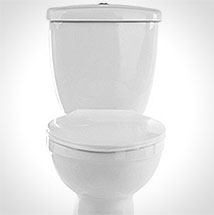Services
Toilets

I've got a serious problem with my toilet.
Toilets are probably the most underappreciated appliance in the home, but get the most attention when they don't operate properly. A toilet is a plumbing fixture and disposal system primarily intended for the disposal of the bodily wastes. There are two basic types of toilets: the dry toilet and the wet toilet. The wet toilet is the most common type and is used in most residential homes. The dry toilet needs no plumbing for water input or evacuation, but is often coupled with some ventilation system.
There are three parts to a toilet; the water tank, the bowl and the siphon tube.
A toilet is ready for use when its water tank is full to the brim, roughly 2 gallons of water. This is the part of the toilet that sits against the wall above the bowl. Inside the tank are refill tubes, overflow tubes, a float and a stopper. When you flush the toilet, a chain attached to the toilet handle and the stopper is pulled, and the stopper is removed from a pipe into which the tank water flows. The water from the tank is pumped directly into the bowl. Once the water is removed, the stopper goes back into place so the tank can be refilled.
Attached to the bowl is a siphon tube that curves so that it will only drain water from the bowl when it reaches a certain height. When the tank water is quickly pumped into the toilet bowl, the siphon tube overflows and the toilet automatically flushes.
Then, after the water has been sucked out of the bowl, the tank and bowl refill. When the tank water level lowers the float inside does as well. When it reaches the bottom the refill device is activated, which sends water into the tank and also into the toilet bowl. More water is sent to the tank until it is refilled. When the float reaches a certain height, the tank stops filling.
New Technologies
Many of today's toilets use advances in water delivery to add to their performance. Dual flush mechanisms combine water conservation and performance which allow the consumer to choose either a standard 1.6 gallon flush or a .8 gallon option. Power Assisted systems use small pumps to increase the pressure of the flush which in turn saves water and money over a period of time. Environmental concerns have given way to the Low Flow toilet which utilizes about one and half gallons of water per flush. These toilets are now considered standard appliances in new homes for their inherent resource savings. Although more popular in Europe and having been around since the 17th century, Bidets are making a strong showing in the United States because of the health benefits and ability to wash portions of the body that are inaccessible.With any plumbing system, problems can exist. At Benjamin Franklin Plumbing we can repair your toilet, or supply and install a new one based on your needs. Contact us today for a comprehensive review of our plumbing needs.
Our Difference
How do you know a company cares about the quality of their work? They stand behind it - that's how. At Benjamin Franklin Plumbing, the warranties and guarantees are industry leading because of our experienced technicians and the high quality parts we use. Our technicians are friendly, clean, polite, drug-free and experienced--and our techniques are state-of-the-art, guaranteed!
A Family Of Home Services:
Strong partnerships and a national support system.
"We service the following areas: Cortland, Creston, Elburn, Wayne, Waterman, Shabbona, Kirkland, Kingston, Genoa, Elgin, Winfield, Wheaton, West Chicago, Malta, Hampshire, Wasco, Virgil, Rochelle"